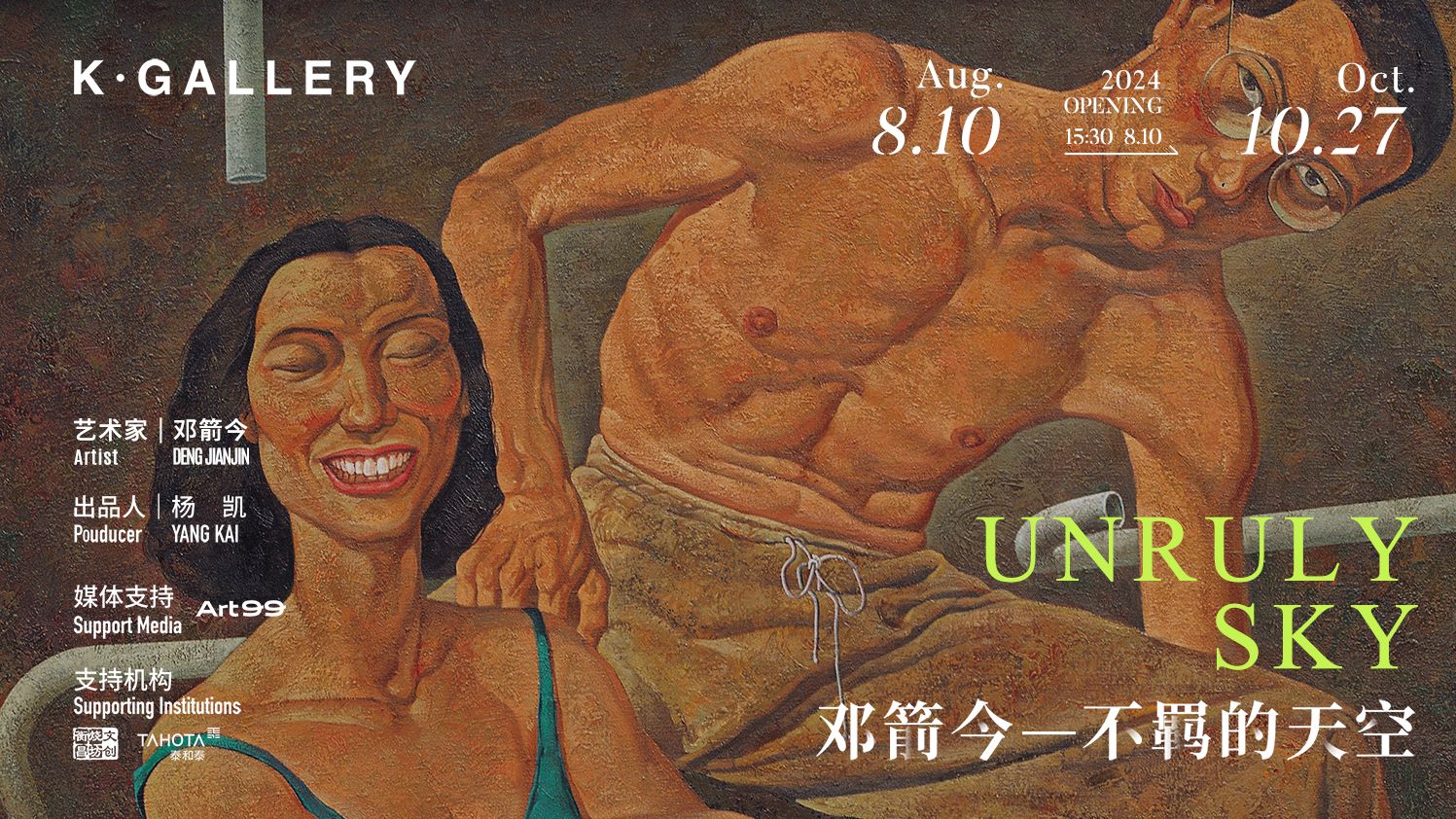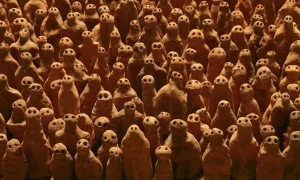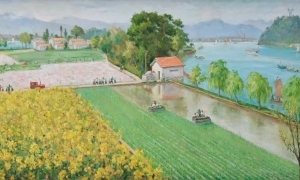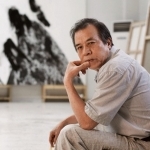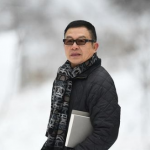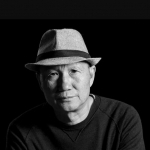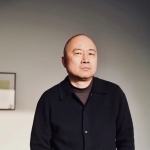米饭是中国人的主食。《论语•乡党》中说:“肉虽多,不使胜食气”。就是说,不要吃太多的肉而不吃谷物。孔子的这句话虽然应当从健康的角度来理解,但他的这一陈述也应该包含了合于礼教和尊崇文化传统的意思,因为传统农业社会的根基在于粮食的生产,而理想的儒家社会建立于稳定的伦理和情感的遵循和守护中。西方人来到中国,最直接感受到的差异之一就是饮食,它来自最基本和直接的身体体验。除了中国人的外表特征外,语言、饮食、文化系统的各种表征使西方人感受到了异质文明的特征。然而在中国现代化的过程中,日常生活已经少有与西方不同体系的元素,衣、食、住、行中唯有“食”还保持着独特的面貌。当代中国处于传统农业社会向工业和后工业社会转化的时期,饮食习惯与文字和各地的方言一样,仍然保留着古老的传统。
米饭有着比西餐中的面包更重要的地位。这是一个从日常经验来了解中国和西方差异的例子。此次18位奥地利艺术家展出的作品有一些直接来源于他们在中国的日常经验。例如Ronald Kodritsch直接将“米饭”的拼音写在他非常个性化的绘画作品上,并且还标注了汉语特有的音调。同样的情况还有画面上的中文“牛肉面”等。G.R.A.M.小组中国戏曲脸谱化妆的西方人形象也是出没于中国城市的各个角落,作用于日常空间和氛围,寻求文化之间背后的和潜在的交流。虽然作品背后有着深刻而复杂的概念和形成的过程,但Michael Höpfner旅行西藏的结果只是非常日常化的当地人的合影和纪念照。Ulrike Johannsen 的作品利用在中国大量出版的时尚杂志。Rainer Prohaska对中国三轮车的改造,以及他在北京街道的行驶并且与街头的普通人的交流都脱胎于对日常的现实生活的观察和认识。还有Ralo Mayer 偶然发现的中文标语横幅,Karel Dudesek 找到的无用的现成物品,Kerstin von Gabain 搜集的被扔掉的纸牌,Lukas Birk用过期的波拉片拍摄的旅游照片等,都是从观察身边的人和事,亲身介入到日常面对的生活当中,以艺术家各自的艺术认识和艺术探索同环境中的现实相契合来创作作品的。
艺术家们还利用了不同文化元素的对照、并置、融合和互动。G.R.A.M.小组的中国戏曲脸谱对应着欧洲人的脸孔和当代人的装束。Ulrike Johannsen的时尚杂志用中文歌词对应着西方产品广告。Matthias Meinharter和Nikolaus Gansterer的传“画”游戏让启动游戏的原稿——墨西哥女画家弗丽达正在创作自画像——逐渐消失在产业化的拷贝图景中。Gerald Nestler 和Sylvia Eckermann对奥地利和中国的艺术家和学者的采访使从各自角度出发的言论聚合到了同一个平台上。Rainer Prohaska的三轮车糅合了不同价值体系下对交通工具的态度。Jasmin Ladenhaufen 从绘画到服装设计再到绘画的操作过程对比和综合了各种因素介入下产生的结果。
欧洲的艺术家对时空概念是敏感的。地点、路线以及到达特定的地点所产生的意义常常出现在他们的作品中。Rainer Prohaska走遍北京的三轮车有精确的轨迹图。Michael Höpfner在西藏的行走也使他体验了预期与到达中种种思想和情感的演化。G.R.A.M.到达了中国,他们用脸谱和错位的载体强调这一点。批量复制油画的深圳大芬村是Matthias Meinharter和 Nikolaus Gansterer作品发生的地点。位置移动和交换是构成Karel Dudesek作品的重要元素,通过地点和场所的改变,物品具有了不同的状态和意义。
在今天的中国,无论来自西方或东方,艺术家们的创作都在一个日益深化和发展的全球化的背景之下。传统的消亡,环境、生活方式、价值观念的急速的转化和变迁达到惊人的程度。Lukas Birk时空错位的作品的意义最能在这种境况中体现出来。他貌似时光倒错的照片探讨和展现了在这样一个快速变化的时代被遮蔽的真实性。而Kamen Stojanov的说唱乐则以一种幽默的方式展现了在全球社会经济动态背景下的地域性事件。Michael Höpfner在作品背景介绍中讲述了进入历史空间中的特殊体验,触及了传统生态价值观在今天的困境,以及对发展和进步的怀疑。Ulrike Johannsen对杂志广告带有批判性的处理表明了艺术家的态度:被指定的行为方式与个性和想象的冲突。虽然Ronald Kodritsch的绘画风格在中国艺术家中属于司空见惯,这同样有赖于中国对西方艺术的学习和借鉴,但他的作品更具灵动的个人色彩,而不像中国艺术家在社会转型当中往往背负很沉重的思想包袱。Matthias Meinharter和Nikolaus Gansterer的“画中画”演绎了一个全球化的产业链的实例,劳动力的价值、手工性、体制化和产业化、文化差异等等系统和表现都被这一作品所衡量和判断。Gerald Nestler和Sylvia Eckermann利用全球化本身所具有的形式来邀请人们谈论全球化的议题,再用非常精巧和个人化的形式呈现出来。Michael Höpfner,Ralo Mayer和 Rainer Prohaska的作品映衬了全球化并非对等的状态:资本、技术、意识形态在全球扩张,而边远地区的劳动力和他们的文化却被禁锢在原地。
艺术家们总是在探索着艺术的内涵和外延以及新的艺术形式的意义。富于行动能力的艺术家总是敏于体验不同于自身文化背景的现实。这种面对和体验伴随着艺术家们对各自的艺术思维进行延续、丰富、发展甚至转化的过程。Matthias Meinharter 和Nikolaus Gansterer的“传画”用误差这一概念作为工具,探讨了我们时代风行的各种强势力量如何作用于个体的内在禀赋和某一文明中延续的传统,浓缩并呈现了一个隐藏的现实。Rainer Prohaska的三轮车在过程中增长发展,并被赋予了交流的媒介的作用,它是对现实的挑战,也是对现实的解释。Ralo Mayer的标语横幅在语义被阻断的情况下用相同的形式来介入表达。Karel Dudesek开始在市场上定做物品而非自己制作或是直接采用存在的物品。
展览中的作品具有多方面和多角度的实验性和当代意义,反映了艺术家们在中国或长或短的多种层面的经验和体悟。无论是对直接相关的身体体验,思想和情感的交流状态,对意识形态议题的探讨,对食物、语言文字、大众文化、地域和场所、日常生活、文化符号等等的关注,这些艺术家们表现出的状况已经同中国刚刚开始开放的时候非常不同了。作为中国观众,人们能感受到交流和互动的加深,以及所产生的更实际和更内在的意义和影响。交流是相互的,希望前往欧洲的中国艺术家们也能将自己内心的体验出色地表达出来,在更深层次的互动中推进人类文化的发展。
张离
2009 10 北京
Sharing Difference
by Zhang Li, October 2009 Beijing
Rice is the staple of Chinese people. “Xiang Dang,” Chapter 10 of The Analects, says: "Excess meat does not a winning meal make." This Confucian adage is meant to warn against consuming excess meat and no grains. While these words should be understood from a health perspective, they also allude to the Confucian ethical code and traditional culture of reverence because traditional agricultural society is founded on grain production and the ideal Confucian social establishment is based in the adherence and safeguard of stable ethics and social relations. One of the most obvious differences Westerners arriving in China notice is the staple food. Aside from physical characteristics, language, diet and various other cultural differences, staple food involves the most direct bodily experience. Given the course of China's rapid modernization, few elements whether in dress, diet or lifestyle, remain distinct from the West besides "food." Contemporary China is transitioning from an agricultural society to an industrial and post-industrial society. Eating habits, like written Chinese and its spoken dialects, have nonetheless maintained its traditional form.
Rice occupies a status that is more important than Western bread. It is an example of the difference between China and the West that can be experienced in daily life. Many works in this exhibit, which features 15 Austrian artists, derive directly from daily life experiences in China. For example, Ronald Kodritsch paints the pinyin for rice ("mifan") directly onto his very individualist painting, even making note of the tonal marks. Similarly, in another work, he paints the Chinese characters for beef noodles (“牛肉面”). The G.R.A.M. group presents a set of photographic works in which they appear with Chinese opera style face painting with different Chinese cities as backdrops. Like the artists’ Western facial features that are masked behind Chinese paint and camouflaged amidst Chinese spaces, the work seeks to reveal hidden and potential opportunities for cultural exchange behind and between cultures. While Michael Hoepfner’s work involves a deep and complex concept and process, the end result of his trip to Tibet is a seemingly straightforward set of travel photos depicting locals and tourism sites.
Ulrike Johannsen's piece makes use of the myriad selection of Chinese fashion magazines. Rainer Prohaska remodels and rides a three-wheel pedicab through the streets of Beijing. His interactions with locals during these rides offer a unique view and familiarization with real daily life. There are also the randomly “discovered” Chinese propaganda banners by Ralo Mayer, the “readymade” objects found by Karel Dudesek, the discarded playing cards collected by Kerstin von Gabain, the travel photographs shot with expired Polaroid film by Lukas Birk and more. These are all works created from the artists’ firsthand observations and experiences of everyday people and events in the same environment, China.
The artists also contrast, juxtapose, fuse and mix different cultural elements. The G.R.A.M. group's use of Chinese opera make-up is a direct contrast to Western facial features and contemporary attire. Ulrike Johannsen's piece juxtaposes Chinese song lyrics with Western advertisements found in fashion magazines. In “Chinese Whispers,” Matthias Meinharter and Nikolaus Gansterer “chain” painting originates with a Frida Khalo Self Portrait and gradually recesses or fuses into a series of commercially reproduced copies. Gerald Nestler and Sylvia Eckermann interviews based on Chinese and Western views on art, nature and environment. While the interviewees never meet each other, their responses are edited into one conversation that spans history, time and ideas of both cultures in what the artists refer to as a “paradox conversation.” Rainer Prohaska's pedicab mixes different socioeconomic attitudes on the issue of transportation. Jasmin Ladenhaufen contrasts and mixes the effect of turning a painting into real life fashion and back into a painting. European artists are sensitive to the concepts of time and space. The various meanings that derive from the start point, itinerary and end point often manifest in their works. Rainer Prohaska made accurate maps of his pedicab journeys across Beijing.
Michael Hoepfner documented the evolution of his thoughts and emotions throughout course of his Tibetan journey. Upon arriving in China, the G.R.A.M. group used dramatic make-up and physical displacement to emphasize both time and place. Dafen, a village in Shenzhen renowned for mass produced oil paintings, is the location of the work by Matthias Meinharter and Nikolaus Gansterer. Physical displacement is a significant element in Karel Dudesek's work. An object that is removed, replaced, or slightly altered takes on a new meaning.
Artists in China today, whether hailing from the West or the East, are producing under an increasingly global backdrop. The disappearance of tradition and rapid transformation in the environment, lifestyle and value systems have reached an alarming degree. The significance of temporal and spatial displacement in Lukas Birk's work is very apparent in this context. His photos distort the sense of time to explore and develop a reality that is hidden by the rapid changes currently underway. Kamen Stojanov's rap song takes a humorous approach to discovering the localism behind a backdrop of global economic trends. In the introduction of Michael Hoepfner’s work, he writes about the unique experience of walking into a historic space and confronting the predicament of a vanishing tradition along with the doubts raised towards development and progress. Ulrike Johannsen's standpoint toward magazine advertisements is clearly a critique of the clash between mainstream fashion and individualistic style. Despite the fact that Ronald Kodritsch's paint style is common among Chinese artists – something that has much to do with Western art education and exposure – his work possesses an individual flair dissimilar to most Chinese art that is often, invariably, burdened by social and historical changes. In "China Whispers," Matthias Meinharter and Nikolaus Gansterer use the example of a painting
factory to critique the global manufacturing chain and its various systems and manifestations such as the value of labor, manual labor, and cultural differences. Gerald Nestler and Sylvia Eckermann edit interviews conducted in a global format and context in an individual style. The works of Michael Hoepfner, Ralo Mayer and Rainer Prohaska challenge the notion of globalization by highlighting elements of labor and culture, particularly in outlying regions, that remain confined to the local.
Artists perpetually explore the meaning of art and new art forms. Artists who work extensively in physical formats are always sensitive to experiences that are different from their own cultural backgrounds. This form of confrontation and experience goes along with artists' process of the continuation, fulfillment, development and even transformation of artistic thinking. Matthias Meinharter and Nikolaus Gansterer use the concept of an error as a tool to explore and expose the ways in which various power structures use inherent and cultural traditions to condense and expose a hidden reality. As Rainer Prohaska's pedicab project developed, it became a vehicle for exchange and both a challenge to and an interpretation of reality. Given a context in which semantics fails, Ralo Mayer's banners find expression in sameness. Karel Dudesek finds and alters or displaces “readymade” objects as opposed to making or purchasing objects.
The works in this exhibition represent an array of experimentation and contemporary meaning. They reflect the artists' multi-faceted experiences and revelations during their stay in China – through direct bodily experience, food, spoken and written language, popular culture, place, daily life, cultural symbols, the exchange of thoughts and feelings, an exploration of an ideology and other themes. Chinese viewers can see the deepened sense of exchange and interaction in the works, as well as the more realistic and inherent meaning and influences they produce. Exchange is reciprocal. I hope that the Europe-bound Chinese artists can also express their experiences as colorfully and meaningfully to contribute to progress in human culture and development.
【编辑:霍春常】




